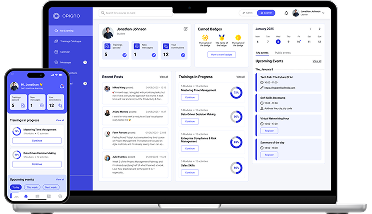Creating effective learning content requires careful consideration of numerous factors: aligning the course with overarching educational objectives, structuring it into separate lessons, selecting tools and approaches, choosing examples and tasks, and so on. Each decision in the course creation process involves many underlying factors that impact how learners engage with the material and, ultimately, how well they achieve their educational goals.
To ensure that nothing is overlooked and that everything ties together seamlessly, one needs a structured action plan that tackles each element step by step. This blog post serves as a high-level guideline to navigate the complexities of course creation. While the steps outlined may seem obvious, having a checklist to refer to can free up mental space for more intricate, nitty-gritty aspects of course development.

1. Organization and planning
1.1. Select the topic
Research the demand for the topics: look at industry trends, survey potential learners, or analyze gaps in the current training programs.
Once a topic is selected, narrow it down to a manageable scope to keep content relevant and digestible. For example, for digital marketing training, decide whether to focus on SEO, content marketing, social media, or a comprehensive overview.
1.2. Understand your target audience
Gather information on your target audience's age, education level, professional background, and prior knowledge of the subject. Use pre-course surveys or diagnostic assessments to determine the baseline knowledge of your audience to avoid redundancy and ensure the content is appropriately challenging.
1.3. Create a macro-level training plan
Determine how the course is positioned in the broader L&D context, what it aims to achieve, and how it's organized within the LMS framework. Create a strategic roadmap: determine the overall course structure within the LMS, the number of modules, the sequence of topics, and how the course fits into a curriculum. If the course is part of a larger program, plan how it integrates with other courses, prerequisites, and follow-up courses.
Map out the overall learner journey, including key milestones or checkpoints within the course, such as quizzes, assignments, or practical exercises, and transitions between modules.
1.4. Define learning objectives
Bloom's Taxonomy provides a hierarchy of cognitive skills ranging from simple recall of facts to higher-order skills like analysis and creation. Use it to set clear, achievable, measurable goals for the course. For instance, instead of a vague objective like "understand project management," aim for something more specific like "analyze project management case studies to identify best practices."
Ensure that each learning objective is directly linked to assessments and activities within the course to measure whether learners have achieved the intended outcomes.
Regularly review and revise the course structure and content based on feedback and evolving needs.

2. Course design and development
2.1. Structure the course
Detail the internal structure of the course. Break it down into self-contained lessons or modules and plan their logical progression from basic concepts to more advanced topics.
Plan the sequence of topics within the module and define how to align information, quizzes, assignments, and multimedia elements with learning objectives. Keep the modules' structure consistent to help learners know what to expect and reduce cognitive load.
Lay out the course navigation with clear paths and minimal distractions. Use progress indicators, a clear menu structure, a search function, bookmarking, or a course map. Ensure that the navigation and layout are mobile-friendly.
2.2. Gather course materials
Curate various resources, including textbooks, scholarly articles, case studies, multimedia, infographics, and interactive media. Incorporate external resources, like relevant websites, online tools, or supplementary readings. Review all collected materials for accuracy and relevance.
Ensure all content is accessible to all learners, including those with disabilities. This might involve adding captions to videos, providing transcripts, or ensuring that documents are compatible with screen readers.
2.3. Create your course
Leverage instructional design models like ADDIE or SAM to maximize learning effectiveness. Ensure that each piece of content has a purpose and contributes to the learning objectives. Use scaffolding to guide learners towards advanced material, e.g., tiered assignments, branching scenarios, or progressive quizzes that adapt to the learner's performance.
Use authoring tools within your LMS to create and organize content and integrate gamification elements (badges, points, and leaderboards) and interactive media (simulations, case studies, etc.). Use consistent fonts, colors, and layouts. Set up discussion forums and community spaces for collaborative work.
Include feedback mechanisms, formative assessments like quizzes and knowledge checks, and summative assessments like final projects or exams.
Finally, don't forget to include the course overview explaining its purpose and objectives, expected outcomes, and how they will benefit the learner.
2.4. Test the course
Before launching the course, run usability testing with a small group of learners or colleagues. Test all technical aspects of the course, including accessibility, links, multimedia content, and interactive elements, to ensure everything functions properly across different devices and browsers, loads quickly, and plays smoothly.
Review the course content: proofread text for errors, check the accuracy of factual information, and ensure that instructions are clear and unambiguous.
Keep detailed documentation of the course design and development process, including decisions made, tools used, and changes implemented. This documentation can be invaluable for future course updates or creating new courses.

3. Publishing and implementation
3.1. Publish the course
Run a thorough final review of the entire course. Check for any content errors, broken links, or technical issues. Ensure the course design adheres to WCAG. Review the course for consistency in language, tone, and formatting. Ensure that all modules are cohesive and align with the overall course objectives.
Once the final checks are complete, publish the course on your LMS. Set appropriate permissions, adjust visibility settings, and ensure that the course is listed in the correct category or catalog within the LMS. Announce the course launch via email newsletters, social media posts, or announcements within the LMS.
3.2. Gather learner feedback
After the course launch, actively seek learner feedback through surveys, discussion forums, or direct communication. Ask for their thoughts on course content, usability, engagement, and overall satisfaction. Make it easy for learners to provide feedback at various points throughout the course, not just at the end.
Carefully analyze the feedback to identify patterns or recurring issues. Pay attention to both positive and negative comments, as both can provide valuable insights for improving the course. Look for specific suggestions on content clarity, engagement strategies, and technical usability.
3.3. Update and iterate
Use the data collected from analytics to identify areas where the course may need improvement. Make necessary course content and structure updates, such as clarifying confusing concepts, adding more examples or interactive elements, or improving navigation.
Update the course content to reflect the new information, industry standards, or technological advancements. Review and refine the course continuously. Consider setting a schedule for periodic reviews, e.g., every six months or annually, to keep the course fresh and engaging.
3.4. Analyze course performance
Use LMS analytics to track learner progress, completion rates, quiz performance, and other key metrics on how learners engage with the course, where they struggle, and which modules are most effective.
Use performance reports to evaluate the course's effectiveness, make data-driven decisions for future course updates, and demonstrate the value of the course to stakeholders.

Get expert technical support for seamless course creation
Creating a successful educational course involves more than just assembling content — it's about thoughtfully planning, designing, and implementing each element to ensure learners have a meaningful and impactful experience.
By thoroughly addressing each of the aspects outlined in this guide, you lay a strong foundation for creating a well-organized and impactful course that meets both educational standards and the diverse needs of your learners.
We understand that this process can be complex and challenging, especially when it comes to the technical aspects of course creation. Our team is here to help you navigate these challenges. Whether you need an e-learning platform, assistance with implementing advanced features for your Opigno LMS, or building interactive content, we're ready to support you every step of the way. Contact us today to turn your L&D vision into a polished, high-quality learning experience.
Published on September 5, 2024
